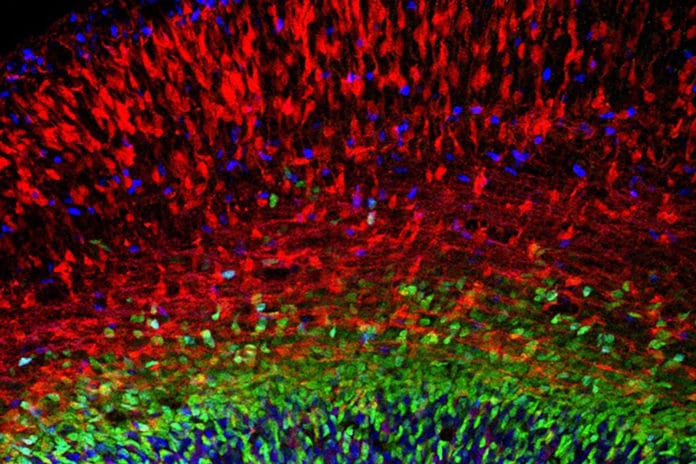The mammalian cerebral cortex has an unparalleled diversity of cell types, generated during development through a series of temporally orchestrated events under tight evolutionary constraints and critical for proper cortical assembly and function. However, the molecular logic that governs the establishment and organization of cortical cell types remains unknown.
The mammalian cerebral cortex is the seat of higher-order cognition and the part of the brain that has expanded and diversified the most during human evolution.
By applying several advanced genomic technologies to the part of the cerebral cortex. Harvard scientists have created a detailed map of a critical region of the developing mouse brain. The map help scientists determine how gene activity and regulation change over time. It also helps them better understand the development of the cerebral cortex.
Scientists used a very fine lens to look at the cortex closely. They especially profiled all of its cells, one by one, every day of development.
By classifying changes in gene expression and regulation at an unprecedented level of temporal resolution, scientists successfully built a first single-cell-resolution molecular map of this fantastic tissue.
Paola Arlotta, the co-senior author of the study, said, “The map allowed us to extract first mechanistic principles governing how the cortex is built, and begin to decode how genetic abnormalities affect such highly controlled process in the embryo.”
Co-senior author Aviv Regev, who was a core institute member at the Broad Institute, said, “In the developing brain, we have to consider three things: the types of cells that are present, where those cells are located, and at what stage they are in development. In addition, by identifying the drivers that direct this process in normal development, we can better understand what may go wrong in disease.”
The somatosensory cortex may serve as a model for other regions of the cerebral cortex. The cells in the cortex represent all of their significant classes.
Scientists focused on the somatosensory cortex. They used multiple technologies to analyze the brain at the single-cell level.
The method called RNA-seq allowed them to measure which genes are expressed and spatial transcriptomics to measure where genes are expressed in the tissue. Another method called ATAC-seq allowed them to measure which parts of the genome were accessible for regulation.
Using these techniques, scientists observed different modes of gene expression and how genes are regulating each other.
Daniela Di Bella, a postdoctoral fellow in the Arlotta lab and co-first author of the study, said, “By combining these three modalities, we have a stronger sense of which are the important genes for directing neuronal development, for example.”
“For instance, it has been unclear exactly when the cortex’s diversity of different neuron populations is established. We found that the different flavors of neurons are decided during the neuron maturation process, rather than pre-established in their stem cells.”
Based on the data, scientists predicted that the underlying mechanism of how genetic mutation leads to defects in cortical development. They also found which specific developmental steps are failing and which cells are being affected.
Co-first author Ehsan Habibi said, “We have created a uniquely comprehensive molecular atlas of the developing somatosensory cortex, and we are continuing to mine the data for more insights. Our goal is for our data to serve as a resource for the wider neuroscience community and inform how the field looks at brain development, both during normal and disease processes.”
Arlotta said, “These combined, extensive measurements provided us with a first dynamic view of the symphony of molecular events that unfold as this critical region of the brain is built in the embryo. Researchers have been studying the process of development of the cerebral cortex for over a century. Still, the mechanical events that govern how cells are made and how they interact to form functional circuits ultimately have remained elusive.”
“As a field, we have historically looked at this complex developing tissue one cell type at a time and investigated small numbers of genes for their roles in putting together pieces of this amazing puzzle. But the brain does not develop one cell type at the time — it is truly a symphony in the sense that hundreds of cell types undergo development together, using ever-changing landscapes of genes to form the adult tissue. Now imagine having for the first time the full ‘recipe’ of genes that any given cell class uses as its development unfolds.”
“Imagine also gaining detailed knowledge of the ‘codes of genes’ that turn on or off as distinct lineages of cells separate from each other and get built. This type of overarching mechanistic knowledge offers an opportunity to study cortical development in a brand new way, looking at all cells and genes. We never had information this complete before, and I must admit that I stared at the data in awe, thinking about the type of discovery that it enables.”
Regev said, “With advances in single-cell and spatial transcriptomics, and new machine learning algorithms for large data analysis, we were able to map where cells develop, put those maps together, and watch development unfold like a movie over time. We could reconstruct the movie and link that picture to a greater biological understanding of brain development. We hope this approach could one day help us better understand and treat diseases of the brain.”
Journal Reference:
- Di Bella, D.J., Habibi, E., Stickels, R.R. et al. Molecular logic of cellular diversification in the mouse cerebral cortex. Nature (2021). DOI: 10.1038/s41586-021-03670-5
